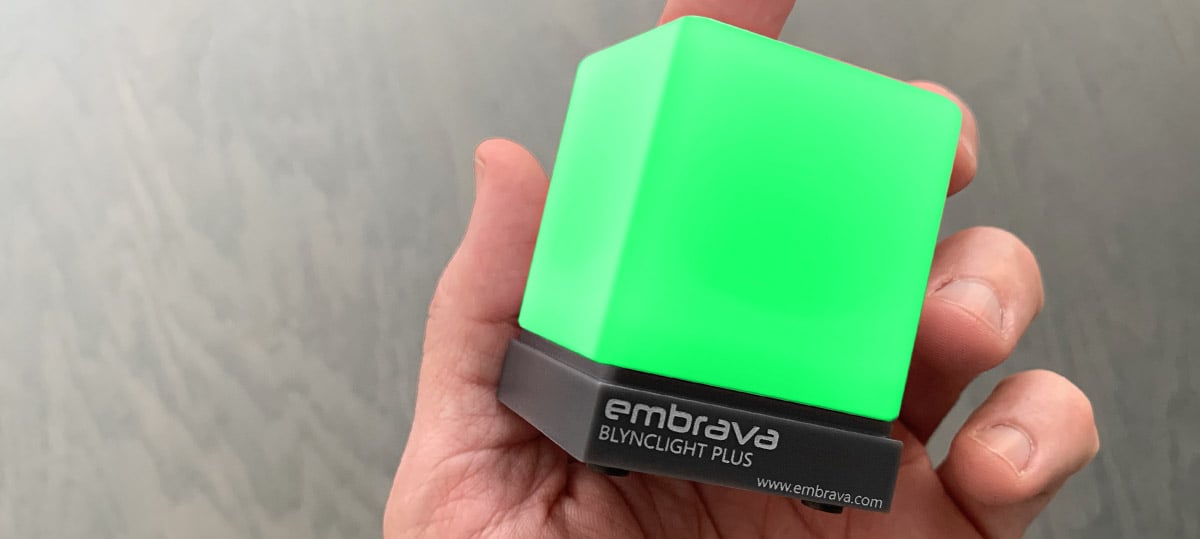
Modern workspaces have come a long way from the stuffy, endless cubicle grids they used to be, with many businesses opting for open floor plans that promote collaboration and flexibility.
Unfortunately, open floor plans also come with their own obstacles. Without closed doors or high-walled cubicles, there is little to indicate an employee’s work status. Many employees wear a headset at all times, which can make it difficult to tell when they are available or busy and therefore make them much more likely to be interrupted.
While most interruptions are short—or maybe even welcomed as a way to break up the day’s monotony—they make it difficult to achieve a flow state. Interruptions also increase the likelihood of errors and contribute to higher exhaustion and stress levels.
Luckily, there’s a tool that serves as a literal and figurative beacon of hope for employees who deal with frequent interruptions—the status indicator light. The simple addition of a status indicator light to each workspace reduces local interruptions, thereby increasing productivity, employee well-being, and your business’s bottom line.
The cost of interruptions
Let’s be real: interruptions are everywhere, but some are easier to ignore than others.
Even if there was a way to properly deflect every distracting notification, chat message, or poorly-timed call or email, you can’t just hit the mute button on a chatty coworker (the top workplace distractor according to a recent study).
According to one study of nearly 1,800 participants, 44% said they can’t count the number of times they are interrupted per hour while at work, while another 36% admitted it was 10 times or more. That means 80% of employees polled were distracted every six minutes on average—and that’s the minimum! When extrapolated to the length of a full workday, that means distractions cost employers 2.1 hours per day or 504 hours per year per employee!
But that’s not all. Another study showed that a distraction as short as 2.8 seconds doubles the rate of error for the average worker. If the distraction lasts over a minute, it can even begin to erase short-term memory, which explains why it takes many people over 20 minutes to get back on track after being distracted.
Considering the amount of time and productivity in question and how quickly they can be compromised, it’s easy to see the negative impact these distractions can inflict.
So how can they be solved?
The benefits of status indicator lights
Status indicator lights are about as simple as they sound—devices that use a color-coded light to alert others as to the user’s availability. But they’re more than just a person-to-person traffic light. They’re able to manage distractions and interruptions in both the physical workspace and the digital one—using one can reduce interruptions by 46%!
Curb interruptions
As mentioned above, coworkers—intentionally or otherwise—are the leading cause of workplace distraction, and it’s easy to see why. A simple drop-in can quickly turn into a full-fledged conversation (we are, after all, social creatures) whether there’s time for one or not.
Status indicators solve this issue by allowing each person to broadcast their availability to the office at large. For instance, if an employee is busy, simply does not wish to be disturbed, or is away from their desk, their status indicator could light up red, purple, or yellow respectively. If the employee is available, the light would show green.
Improve collaboration and communication
It takes time for someone to put down their work, walk to a colleague’s desk, ask a question, walk back, and get back on track. And waiting around for a colleague to become available before being able to talk tacks on even more time to the process. On the other hand, it only takes a second to check a status indicator light. If your colleague isn’t available, you can plan to circle back to them later, allowing both of you to focus on the task at hand.
Help workers maintain focus from afar
Besides keeping interruptions to a minimum, status indicators can also act as alert lights. They can be configured with various colors, noises, and flash patterns to indicate that there is an active call coming in or that calls or messages have been missed, allowing employees to leave their desks while still keeping an eye on their work—perfect for those who work in an open office environment.
Eliminate the need to set status manually
There are lots of status-setting solutions that go along with workplace messaging, but most still require manual triggering. Even the most mindful worker forgets to update their availability from time to time, leaving clients and coworkers not only unaware of the actual status but distrusting of the system.
Fortunately, some status indicators can be paired with a patented software technology that utilizes algorithms to learn how a user works, detect when they’re focused on a task and automatically set their status accordingly, alleviating the need for employees to manage it manually!
Get status indicators to get productive
While it’s impossible to combat every workplace interruption, status indicators can reduce them by a whopping 46%. Whether your employees are plagued by chatty coworkers, the constant bombardment of digital correspondence—or most likely, both—adopting a smart status indicator system is the all-in-one solution you need.
Want more info about boosting productivity with status indicators?
Book below to find a time to chat with a workplace productivity expert!
















